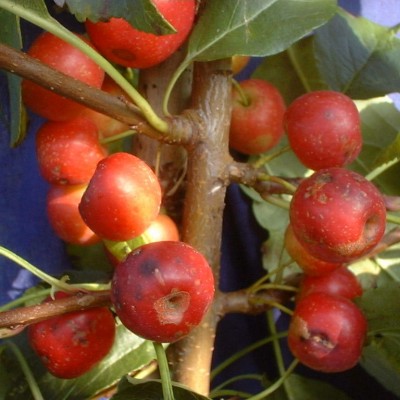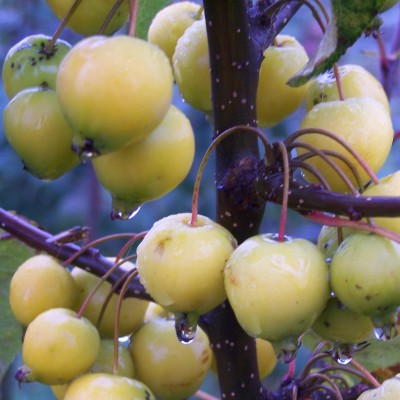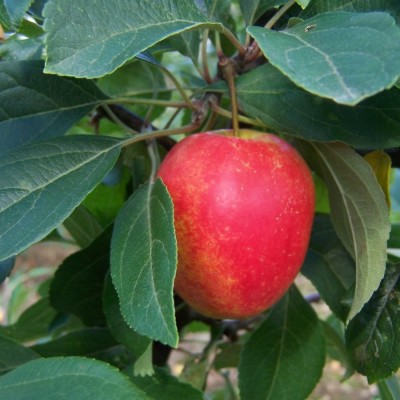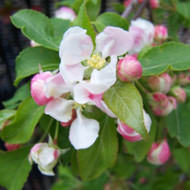
For many of us who strive to ‘grow our own’, the beauty of a plant often takes a back seat to usefulness. We care less about what a tree looks like, instead obsessing over flavour, cooking qualities and cropping times. However the kitchen garden has always been a place where aesthetics were at least as important as taste – think of Victorian walled gardens with immaculate espalier fruit trees along the walls, or French-style potagers with box edging and symmetrical paths giving form and structure to a productive area of the garden. Whilst there is an undeniable beauty to a row of Cavolo Nero in late winter, leaves glistening with frost, there are plenty of plants which combine more classical good looks with a useful crop – none more so than the humble crab apple.
In its broadest meaning, a crab apple is any wild apple. Apples, famously, do not come true from seed – plant the six or seven pips from your lunchtime Braeburn and you will end up with 6 or 7 unique seedlings or crabs which can vary dramatically in terms of vigour, health and the fruit they produce. Studies have shown that apples contain twice as many genes as humans, so the scope for diversity amongst offspring is huge. The name ‘crab apple’ is thought to be derived from the Norse term for wild apple, which possible alluded to the sideways, twisted growth.
Over the past two hundred years, many forms have been identified as having particularly good blossom or fruit, and it is these cultivated varieties that hold the most interest for the modern gardener. The trees are very hardy and easy-to-grow, thriving in most soils and situations, and are generally pest and disease-resistant. The blossom in Spring is as pretty as any flowering cherry and lasts for much longer. One of the reasons you will sometimes hear crab apples recommended as good pollinating partners is that the they flower for such a long period and overlap with most pollination groups. The sheer quantity of flowers produced ensures that there is a good supply of viable pollen for visiting bees. Crabs are generally very heavy and consistent croppers – no need to thin the crop. A crab apple in full fruit is one of the delights of autumn, boughs weighed down with jewelled treats. They are also an invaluable addition to any wildlife friendly garden – as well as pollen for bees, the fruit will provide a welcome source of food for birds during the late autumn and winter.
As we have seen, varieties have to be budded or grafted onto a rootstock in order to be ‘true’. You will sometimes see them offered on a dwarfing rootstock such as MM06. Whilst this can be a good option if you are really tight for space, they can struggle in less than ideal spots. By far the best rootstock is Malus sylvestris, the wild species. This is a vigorous rootstock and will produce full sized crab apple trees 5 – 7m tall at maturity, but the tree are very easy to keep smaller through winter pruning. They will survive in harsh conditions and poor soils, which will naturally reduce their ultimate size. It is also probably the best option if you are growing in a pot - again, the pot will restrict root growth and limit the ultimate size of the tree, but the rootstock has enough vigour to remain healthy and produce good crops.

Recommended varieties:
‘John Downie’ – an old favourite, and reputed to produce the finest crab apple jelly. Heavy crops of elongated orange fruit flushed with red. It is a great variety, but does have a couple of drawbacks – the fruit drops off the tree as soon as it is ripe so needs to be used straight away and it can get a little scab in wetter climates. Still one of the best for flavour though.
‘Golden Hornet’ – a cracker. Superb display of blossom, followed by round yellow fruit which hang on the tree until Christmas. Excellent flavour. Growth is a little more upright than some others, so a good choice if space is tight.
‘Dartmouth’ – heavy crops of bright red fruit, this looks an absolute picture through late summer and into autumn, as if hung with Christmas decorations. Again, cooks extremely well. Good display of almost pure white blossom.
‘Red Sentinel’ – one of the most ornamental crabs – white blossom and heavy crops of small bright red fruit. The fruit is smaller than some of the other varieties, so preparing it is a bit of a labour of love, but it does have a good flavour. Neat in growth, this is the variety to choose if you want to grow as a pleached or espalier tree.

Uses:
Most people have heard of crab apple jelly, but seemingly few people actually make it these days. This is a real shame, as it’s pretty simple to make and has loads of uses – it goes very well lamb or pork, as well as pheasant. I like to eat it spread on hot buttered toast along with a slice of cheese – absolutely delicious! Although the crabs provide a level of tartness, it is basically a sweet jelly, so you can even use it in cake fillings or as an accompaniment to a scone and cream.
As a single tree will provide plenty of fruit, don’t limit yourself to just making jelly. You can also steep the fruit in alcohol and a little sugar to make a very fine apple liquor. Wash and halve about 40 crabs, and put into a preserving jar. Add 1 litre of vodka and 200g castor sugar. Leave the jar for a month or two (longer is better!), turning the jar every week or so. Decant into a clean bottle, using a muslin cloth over the neck to sieve out all the bits.
Add a few crabs (cored, peeled and chopped) into a bread and butter pudding – they work very well with a dusting of brown sugar and caramelise wonderfully. Use spices such as cloves, cinnamon and nutmeg to add to the Autumnal flavour, and make full use of this most versatile tree.

